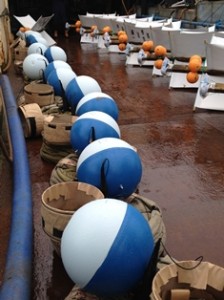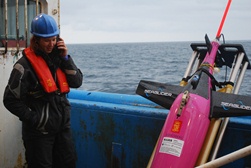Marine
Crossing the edge: from coastal seas to open ocean
September 5, 2014 by Marine Directorate Communications No Comments | Category Marine Directorate general, Marine Directorate Science
By Bee Berx
The Faroe Shetland Channel (FSC) is a key connection between the Atlantic Ocean and the Nordic Seas. The flow of warm, saline Atlantic water polewards, and the underlying equatorward cold overflow are important branches of the Atlantic overturning circulation. Marine Scotland Science (MSS), in collaboration with the Faroese Marine Research Institute (FAMRI) and University of Bergen (UiB), has contributed to North Atlantic monitoring for a number of years. Traditionally, this work has involved ship-based surveys measuring temperature, salinity and the flow of water throughout the water column.

The drifters line up at the race start line (50 m drogued drifters are on the left hand side, 1 m drogued ones are to the right).
In May 2014, researchers from MSS and the Scottish Association for Marine Science (SAMS) deployed ocean drifters during a research cruise aboard MRV Scotia to observe the Scottish slope current and its variability. Ten drifters were drogued at 1 m depth (this means they are designed to be pushed along by the currents at this depth), and 15 were drogued at 50 m depth. A satellite tracker at the water surface transmits the drifter’s GPS position to our computers, allowing us to remotely track their progress. During the summer, the drifter race was broadcast via the drifters’ own webpages (see embedded links above), as well as via regular Twitter updates.
Although drifters can provide valuable information on the region’s circulation, they are passive, and once released scientists are unable to influence their path. This is not the case for the more recently developed gliders, which can be directed by scientists from land. During summer 2014, two gliders were deployed to observe key physical parameters along one of the standard hydrographic monitoring lines (the Fair Isle Munken line). In May 2014, Knockando was deployed from MRV Scotia, and the scientists from SAMS piloted the glider to travel between the Faroe and Shetland Isles. During its deployment, the glider was also instructed to hold position near one of the moored current meters. The strong currents in the region meant this was no mean feat to achieve. In August 2014, MPV Jura–one of Marine Scotland Compliance’s vessels- helped recover Knockando when she ran into trouble in the FSC at the start of August. The experienced crew then assisted with the deployment and recovery of the second glider: Orca from the University of East Anglia (UEA).
Unfortunately, this second deployment had to be cut short, but this close collaboration between scientists from MSS, SAMS and UEA, as well as the involvement of Marine Scotland Compliance officers and crew, saw the first successful deployment of gliders in the Faroe Shetland Channel. An experience we hope to build on in the near future.
Acknowledgements: This work was done in collaboration with Dr Marie Porter, Prof Mark Inall and the SAMS glider team, and Dr Rob Hall and the UEA glider team. We are very grateful to MPV Jura’s officers and crew for the safe return of both Knockando and Orca.



Leave a comment